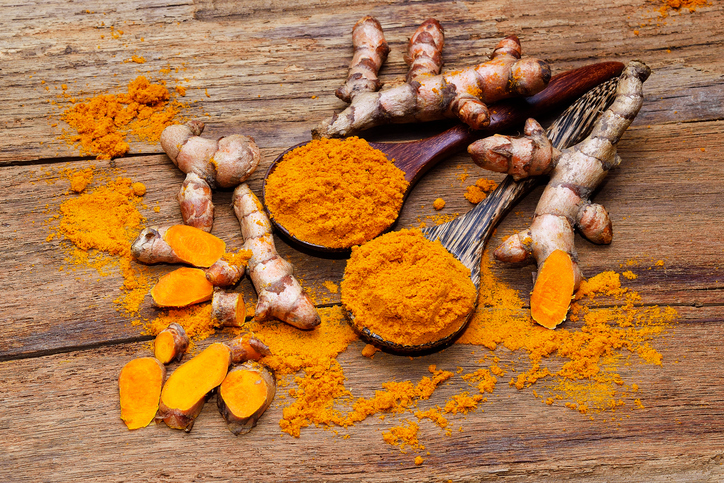
Wouldn’t it be nice to be able to use herbs and spices to heal some of today’s most complicated diseases instead of some costly, experimental drugs? Well, in some cases you can! Turmeric, or Haldi, as they call it in Hindi, has been historically used for its spiritual significance, but there’s so much more to this spice–and now doctors are starting to take serious notice, too.
Often referred to as The Golden Spice, Kitchen Gold or The Spice of Life, turmeric is a common accessory in wedding rituals and prayer ceremonies in the Eastern part of the world.
Originally the spice was used in rites and rituals intended to promote fertility, prosperity, and spiritual purification.
But soon, those who used turmeric saw its healing properties and started sharing it for various ailments. As a matter of fact, doctors have confirmed that this over-the-counter spice is more effective at treating seven different ailments than prescription medicine!
Now, as more are becoming familiar with the spice, it is being used as a powerful tool in conjunction with, or, in some cases, in replacement of certain medications to fight off a number of diseases. Here are just a few.
What It Can Be Used for/Or Replace:
1. Antiseptic
Turmeric is incredibly purifying.
As a sure source of anti-fungal, anti-microbial, and anti-bacterial extracts, this spice can help you fight infections and boost immunity.
How to Use It: You can mix turmeric with warm water to create a paste and apply it to wounds. This can help reduce pain, swelling, and tissue necrosis. You can also sprinkle turmeric powder directly on cuts or burns.
2. Reduces the Risk of Childhood Leukemia
Symptoms of leukemia are often caused by problems in the child’s bone marrow, which is where the leukemia begins.
As leukemia cells build up in the marrow, they can crowd out the normal blood cell production. As a result, a child may not have enough normal red blood cells, white blood cells, and blood platelets.
Turmeric helps to strengthen blood cell production.
3. Natural Liver Detoxifier
Turmeric provides a natural and easy flow of the bile duct, a liver cleanser. Adding turmeric could improve your liver function. Though African Americans represent 13 percent of the U.S population, they make up about 22 percent of the cases of the chronic liver disease hepatitis C.
In addition, numbers published by the National Medical Association from the CDC show that four of every 100 infants born to African-American mothers with hepatitis C become infected with the virus.
Chronic liver disease, often hepatitis C-related is the leading cause of death among African Americans ages 45 to 64.
How to Use It: There are two main ways you can use turmeric to detox your liver
1. Turmeric mixed with warm water.
You only need to prepare 1 single ingredient – turmeric starch.
You should drink between 2 – 4 grams of turmeric mixed with warm water every day. The best time to drink turmeric juice is in the morning, this is the time that helps the body best absorb the nutrients in turmeric that help improve fatty liver.
2. Turmeric mixed with honey.
Honey contains many antioxidants that prevent cancer and have antibacterial properties that benefit your health.
Turmeric combined with pure honey is considered one of the most effective ways to protect your liver with an at-home treatment.
4. Prostate Cancer Preventer
When combined with cauliflower, turmeric has been shown to prevent the signs of an enlarged prostate and prostate cancer.
How to Use It: The roots of the turmeric plant are boiled, dried, and then ground into a fine consistency to create this spice.
It’s used in everything from food and textile dye to herbal medicine. In addition to a cooking spice, turmeric is also available as:
- a supplement
- a fluid extract
- an herbal tincture
You should aim for 500 milligrams (mg) of curcuminoids, or about 1/2 teaspoon of turmeric powder, per day. Doses of 1,500 mg of curcuminoids, or about 1 1/2 teaspoons of thermic powder, per day may cause side effects.
If you don’t’ want to take it as a supplement, you can also use the spice when cooking. Add a dash of the spice to your egg salad, sprinkle it on some steamed cauliflower, or mix it into brown rice. For best results, add black pepper to the recipe. The piperine in the pepper will help your body properly absorb the curcumin.
5. Natural Pain Killer
The percentage of Americans who take painkillers stronger than morphine is on the rise, according to a new report by the Centers for Disease Control and Prevention (CDC).
These drugs include oxycodone, hydromorphone, fentanyl and methadone.
The study found 37 percent of people who used a prescription narcotic painkiller in 2011-2012 used a drug stronger than morphine, compared with 17 percent in 1999.
How to Use It: For different kinds of pain, check out these suggestions below.
- For osteoarthritis joint pain, take 500 milligrams two to four times daily for four to 12 weeks.
- The Arthritis Foundation recommends taking 400–600 mg of turmeric capsules up to three times per day.
- Mix a teaspoon of turmeric with a cup of milk, such as dairy, coconut, or almond milk. You can also add a small amount of honey or cinnamon for taste
6. Natural Treatment For Rheumatoid Arthritis
Because of its inflammatory properties, turmeric has been known to shrink and deplete the inflammation associated with rheumatoid arthritis.
Arthritis is the leading cause of disability in the United States, affecting 1 in 5 adults.
It interferes with work and other daily activities and can complicate the management of other chronic diseases. Arthritis encompasses more than 100 diseases and conditions that affect joints and other connective tissue.
7. Prevents the Spread Of Multiple Sclerosis
In a recent study using mice, turmeric has been shown to prevent the spread of multiple sclerosis.
The myth that African Americans do not get MS is just that — a myth. African Americans do get MS. Studies suggest that MS can be especially active.
African Americans: are more likely to experience more relapses, more likely to experience greater disability, have a greater risk of progressing to require ambulatory assistance earlier, and are more likely to develop involvement of the optic nerves and spinal cord (optic — spinal MS) and inflammation of the spinal cord (transverse myelitis).









